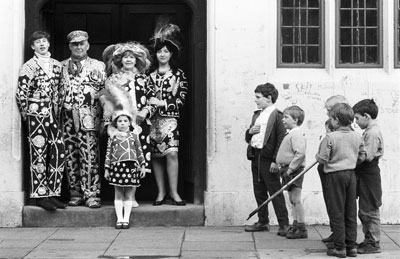 Cao Zhen caozhen0806@126.com A BUTCHER holding a string of haggis, a soldier lurking on a Belfast street, a group of Welsh miners resting at a weekend gathering and a London commuter gobbling hams and sausages — these are some of the subtly captured moments featured in a photo exhibition in Shenzhen tracking fragments of U.K. life over the past five decades. “Work, Rest and Play,” a free exhibition being held in OCT-LOFT, showcases 400 remarkable photos from 38 British photographers. Curated by The Photographers’ Gallery in London, the exhibition presents a broad range of images that reflect the changing face of British society and culture over the past 50 years. Some of the most significant photographers of the time include Cecil Beaton, Terence Donovan, Anna Fox, Tony Ray-Jones, Martin Parr, Mark Neville, Philip Jones Griffiths and Patrick Ward. Arranged chronologically, the photos focus on work, rest and play, as the exhibition’s theme indicates. Most of the photographers turned their lenses on ordinary British people and landscapes. They used an objective documentary-photography approach while maintaining sensitivity for their subjects. In many ways, they are social anthropologists with a camera and an eye for details. Ray-Jones, Parr and Ward are influential documentary photographers in Britain for their enduring subjects: the English at leisure and the class system. Streets and the seaside were their main backdrops. Ward also photographed the eccentric English rituals of Eton Boarding School while Parr brought a wry eye to his images of conservative English dinner parties. Similarly, Fox provided the ordinariness of British office life in the 1980s but with satirical captions, showing her critical observation of the highly competitive character of urban working life. In her “Work Stations” series (1987-1988), a photo captures a well-dressed Londoner devouring hams and sausages with the caption, “Fortunes are being made that are in line with the dreams of avarice.” Fascinated by traditional British crafts, Toby Glanville photographed what he saw as artisans within the food industry and manual laborers in other occupations. In his photo series “Bread and Stone” (1988-1999), he humorously yet seriously portrayed a stone mason, a haggis maker, a cheese maker and many more. Commenting on the exhibition, British art critic Lucy Soutter said that the British have a centuries’ old tradition of self-criticism, satire and parody, grounded in a lively, argumentative popular press, so even when those photographers show poverty, social problems, vanity or vulgarity, they tend to do so with a certain warmth and humor. Apart from leisure and work memories, there are also tense snaps of political moments shown at the exhibition. Griffiths recorded the incongruities of Irish people’s daily lives in the urban war zone in Belfast in 1973. His black-and-white photos have brilliantly complex compositions: an Irish woman weeds her garden while a British soldier holds a gun behind a shrub in front of her; three Irish women with their children walk outside a supermarket while a British soldier lurks on the ground in a corner with watchful eyes. These photos showcase a strange and strained symbiosis of ordinary Irish residents and ever-present British soldiers at that time. Another photographer, Paul Seawright, revisited the sites of sectarian murders that took place during the 1970s close to where he grew up in Belfast. He took 12 color photos in the 1990s and captioned the images with newspaper reports of the deaths, but he removed all references to the religion of the innocent civilian victims, all of whom had been killed for their perceived religion, because he wanted to focus on the cruel and arbitrary nature of the conflict between Protestants and Catholics in North Ireland. At the exhibition, some of the images were made as art and some celebrity portraits were for commercial magazines, such as snaps of Benedict Cumberbatch by Spencer Murphy and Mick Jagger by Beaton. In the 2000s section, contemporary British photography can be seen as installations, videos and performances. “Together, these photos trace a Britain that is characterized above all by its diversity and resilience. Much of the work is critical of the nation depicted, much is celebratory and many works combine the two impulses,” said critic Soutter. | 
